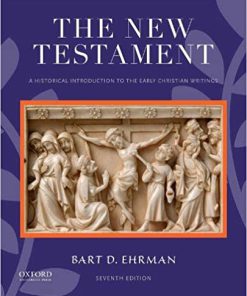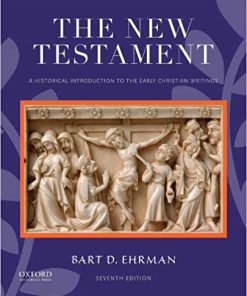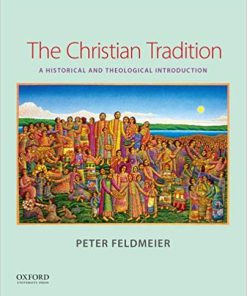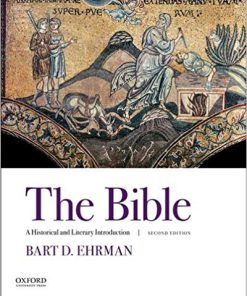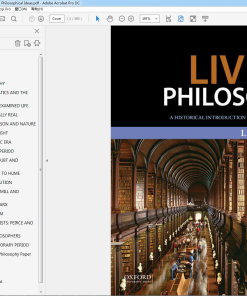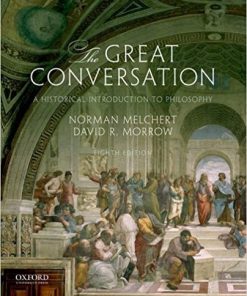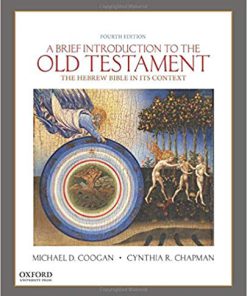(eBook PDF) The New Testament A Historical Introduction to the Early Christian Writings 6th Edition
$50.00 Original price was: $50.00.$35.00Current price is: $35.00.
(eBook PDF) The New Testament A Historical Introduction to the Early Christian Writings 6th Edition – Instant Download
(eBook PDF) The New Testament A Historical Introduction to the Early Christian Writings 6th Edition – Digital Ebook – Instant Delivery Download
product details:
- ISBN-10 : 019020382X
- ISBN-13 : 978-0190203825
- Author: Bart D. Ehrman
Featuring vibrant full color throughout, the sixth edition of Bart D. Ehrman’s highly successful introduction approaches the New Testament from a consistently historical and comparative perspective, emphasizing the rich diversity of the earliest Christian literature. Distinctive to this study is its unique focus on the historical, literary, and religious milieux of the Greco Roman world, including early Judaism. As part of its historical orientation, the book also discusses other Christian writings that were roughly contemporary with the New Testament, such as the Gospel of Thomas, the Apocalypse of Peter, and the letters of Ignatius.
table of contents:
Introduction: Why Study the New Testament?
1. What Is the New Testament? The Early Christians and Their Literature
The Diversity of Early Christianity
The New Testament Canon of Scripture
Implications for Our Study
Excursus 1: Some Additional Reflections: The Historian and the Believer
2. Do We Have the Original New Testament?
Publishing Books: Now and Then
How Can We Know if We Have an Ancient Author’s Actual Words?
What Manuscripts of the New Testament Do We Have? The Good News and Bad News
A Concrete Example
Accidental Mistakes
Intentional Errors
Criteria for Establishing the Text
Photo Essay 1: Ancient Manuscripts of the New Testament
3. The Greco-Roman World of Early Christian Traditions
The Problem of Beginnings
One Remarkable Life
The Environment of the New Testament: Religions in the Greco-Roman World
4. The Jewish World of Jesus and His Followers
Judaism as a Greco-Roman Religion
Political Crises in Palestine and Their Ramifications
The Formation of Jewish Groups
5. From Oral Traditions to Written Gospels
Oral Traditions behind the Gospels
The Earliest Christian Gospels
The Question of Genre
Biography as a Greco-Roman Genre
The Gospels as Ancient Biographies
Excursus 2: Some Additional Reflections: The Authors of the Gospels
6. Jesus, the Suffering Son of God: The Gospel According to Mark
The Beginning of the Gospel: Jesus the Messiah, the Son of God Who Fulfills Scripture
Jesus the Authoritative Son of God
Jesus the Opposed Son of God
Jesus the Misunderstood Son of God
Jesus the Acknowledged Son of God
Jesus the Suffering Son of God
Jesus the Crucified Son of God
Jesus the Vindicated Son of God
Conclusion: Mark and His Readers
7. The Synoptic Problem and Its Significance for Interpretation
Methods for Studying the Gospels
The Synoptic Problem
The Methodological Significance of the Four-Source Hypothesis
8. Jesus, the Jewish Messiah: The Gospel According to Matthew
The Importance of Beginnings: Jesus the Jewish Messiah in Fulfillment of the Jewish Scriptures
Jesus and His Forerunner from Matthew’s Perspective
The Portrayal of Jesus in Matthew: The Sermon on the Mount as a Springboard
Jesus and the Jewish Cultic Practices Prescribed by the Law
Jesus Rejected by the Jewish Leaders
Matthew and His Readers
9. Jesus, the Savior of the World: The Gospel According to Luke
The Comparative Method and the Gospel of Luke
A Comparative Overview of the Gospel
The Preface to Luke’s Gospel
Luke’s Birth Narrative in Comparative Perspective
From Jew to Gentile: Luke’s Portrayal of Jesus the Rejected Prophet
Luke’s Distinctive Emphases throughout His Gospel
Conclusion: Luke in Comparative Perspective
10. Jesus, the Man Sent from Heaven: The Gospel According to John
The Gospel of John from the Perspective of Genre Criticism
The Gospel of John from a Comparative Perspective
The Gospel of John from a Redactional Perspective
The Socio-Historical Method
The Gospel of John from a Socio-Historical Perspective
The Author of the Fourth Gospel
Excursus 3: Methods of Ideological Criticism
11. From John’s Jesus to the Gnostic Christ: The Johannine Epistles and Beyond
The Questions of Genre and Author
The New Testament Epistolary Literature and the Contextual Method
The Johannine Epistles from a Contextual Perspective
Reflections on the Contextual Method
Beyond the Johannine Community: The Rise of Christian Gnosticism
Major Views of Various Gnostic Groups
Gnostics and the Johannine Community
12. Jesus from Different Perspectives: Other Gospels in Early Christianity
Narrative Gospels
Marcion’s Gospel
Sayings Gospels
Infancy Gospels
Passion Gospels
Conclusion: The Other Gospels
13. The Historical Jesus: Sources, Problems, and Methods
Problems with Sources
Non-Christian Sources
Christian Sources
Using Our Sources: Some of the Basic Rules of Thumb
Specific Criteria and Their Rationale
Conclusion: Reconstructing the Life of Jesus
Excursus 4: The Historian and the Problem of Miracles
14. Jesus in Context
Popular Modes of Resistance to Oppression
An Ideology of Resistance
Jesus in His Apocalyptic Context
Photo Essay 2: The Material World of Jesus and the Gospels
15. Jesus, the Apocalyptic Prophet
The Apocalyptic Deeds of Jesus
The Apocalyptic Teachings of Jesus
The Apocalyptic Death of Jesus
16. From Jesus to the Gospels
The Beginning of Christianity
Jesus’ Resurrection from an Apocalyptic Perspective
Jesus’ Death, According to the Scriptures
The Emergence of Different Understandings of Jesus
17. Luke’s Second Volume: The Acts of the Apostles
The Genre of Acts and Its Significance
The Thematic Approach to Acts
From Gospel to Acts: The Opening Transition
Themes in the Speeches in Acts
Conclusion: The Author and His Themes in Context
Excursus 5: The Author of Luke-Acts and His Audience
18. Paul the Apostle: The Man and His Mission
The Study of Paul: Methodological Difficulties
The Life of Paul
19. Paul and His Apostolic Mission: 1 Thessalonians as a Test Case
The Founding of the Church in Thessalonica
The Beginnings of the Thessalonian Church: A Socio-historical Perspective
The Church at Thessalonica after Paul’s Departure
Conclusion: Paul the Apostle
20. Paul and the Crises of His Churches: 1 and 2 Corinthians, Galatians, Philippians, and Philemon
1 Corinthians
2 Corinthians
Galatians
Philippians
Philemon
21. The Gospel According to Paul: The Letter to the Romans
The Occasion and Purpose of the Letter
The Theme of the Epistle
Pauline Models for Salvation
The Flow of Paul’s Argument
Conclusion: Paul and the Romans
Photo Essay 3: The Cities and Roads of Paul
22. Does the Tradition Miscarry? Paul in Relation to Jesus, James, Thecla, and Theudas
Paul in Relation to What Came Before
Paul in Relation to What Came After
Conclusion: Pauline Christianities
23. In the Wake of the Apostle: The Deutero-Pauline and Pastoral Epistles
Pseudonymity in the Ancient World
The Deutero-Pauline Epistles
The Pastoral Epistles
The Historical Situation and Authorship of the Pastoral Epistles
Conclusion: The Post-Pauline Pastoral Epistles
24. From Paul’s Female Colleagues to the Pastor’s Intimidated Women: The Oppression of Women in Early Christianity
Women in Paul’s Churches
Women Associated with Jesus
Paul’s Understanding of Women in the Church
Women in the Aftermath of Paul
Ancient Ideologies of Gender
Gender Ideology and the Pauline Churches
25. Christians and Jews: Hebrews, Barnabas, and Later Anti-Jewish Literature
Early Christian Self-Definition
Continuity and Superiority: The Epistle to the Hebrews
Discontinuity and Supremacy: The Epistle of Barnabas
Conclusion: The Rise of Christian Anti-Judaism
Excursus 6: The Digital Bible
26. Christians and Pagans: 1 Peter, the Letters of Ignatius, the Martyrdom of Polycarp, and Later Apologetic Literature
The Persecution of the Early Christians
Christians in a Hostile World: The Letter of 1 Peter
Christians Sentenced to Death: The Letters of Ignatius
Christians before the Tribunal: The Martyrdom of Polycarp
Christians on the Defensive: The Later Apologetic Literature
27. Christians and Christians: James, the Didache, Polycarp, 1 Clement, Jude, and 2 Peter
The Epistle of James
The Didache
Polycarp’s Letter to the Philippians
1 Clement
2 Peter
Conclusion: Conflicts within the Early Christian Communities
28. Christians and the Cosmos: The Revelation of John, The Shepherd of Hermas, and the Apocalypse of Peter
Introduction: The End of the World and the Revelation of John
The Content and Structure of the Book of Revelation
The Book of Revelation from a Historical Perspective
Apocalyptic Worldviews and the Apocalypse Genre
The Revelation of John in Historical Context
The Shepherd of Hermas
The Apocalypse of Peter
Glossary of Terms
Index
people also search:
tithes and offering scriptures in the new testament
the new testament was written in what language
how old is the new testament
the new testament ancient rome
where does the new testament start
who wrote the new testament
animated stories from the new testament
You may also like…
Art
(eBook PDF) The New Testament: A Historical Introduction to the Early Christian Writings 7th Edition
Uncategorized
(eBook PDF) The New Testament: A Historical Introduction to the Early Christian Writings 7th Edition
Social Science
(eBook PDF) The Great Conversation: A Historical Introduction to Philosophy 8th Edition
Ebook-PDF
(eBook PDF) A Brief Introduction to the Old Testament: The Hebrew Bible in Its Context 4th Edition






